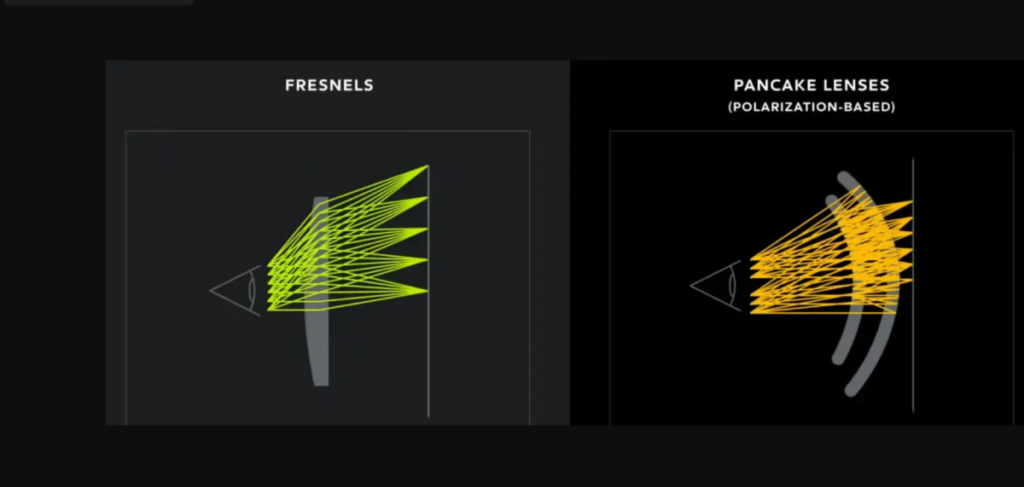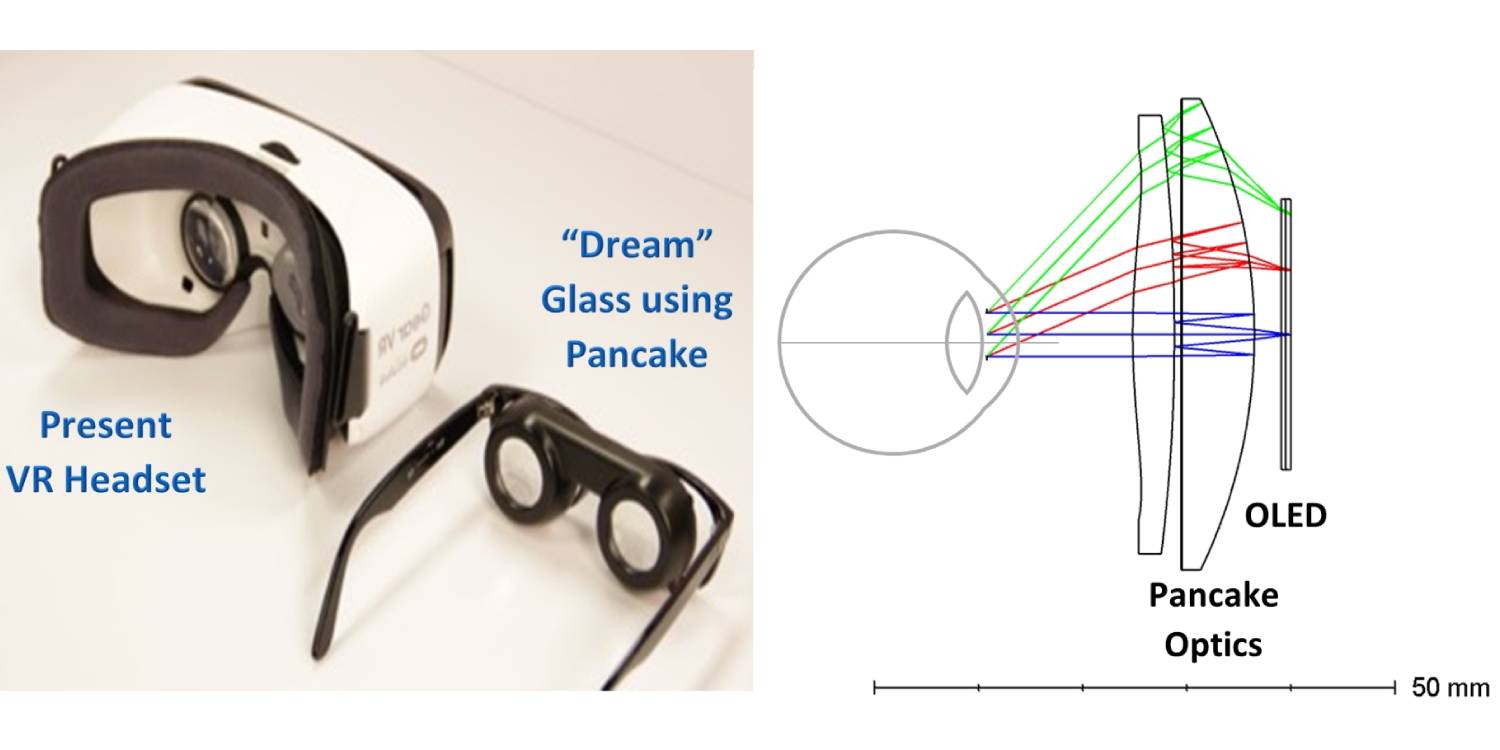Plastic Optics in VR Headsets For More Comfort of VR Porn!
Kopin Corporation, a manufacturer and supplier of high-resolution microdisplays, has developed an all-plastic "Pancake" technology lens with breakthrough performance for virtual, augmented, and mixed reality applications. Will pancake optics displace solutions from Fresnel? And will they be used to enhance the comfort of watching virtual reality porn videos? Let us try to answer these questions. "This major breakthrough represents a milestone for the growing VR market. Massive, heavy headsets have been a major barrier to faster adoption among consumers for many years," said Kopin's CEO and founder, John CC Fan. Pancake lenses have been used in head-mounted displays (HMDs) for decades in medical labs and the military. Today, they are seen as a promising route to compact headsets because they allow the display to be much closer to the lens and thus physically smaller. In 2015, eMagin showed an extremely compact HMD prototype using pancake lenses combined with custom microdisplays. Kopin showed a similar design with its microdisplays in 2017. Panasonic and Pico recently unveiled compact headset concepts with pancake lenses. Huawei launched a pancake lens product in China in December 2019 using small LCD panels. Without a tracking system or battery, these devices weigh about 150 grams. Huawei's Glass VR, sold in China as of late 2019, weighs 166 grams – and as you could have already guessed, this may increase the comfort of long sessions with VR porn scenes by a ton!
Pancake Optics?
The primary factor affecting the size and weight of today's virtual reality devices is the optical design. Most goggles use relatively large and thick Fresnel lenses to augment the smartphone-sized display, which is sometimes split in two. A large gap is required between the lenses and the display. When the case is added, even the most streamlined designs end up with more than 400 grams, which can be pretty heavy if you want to spend hours watching stuff like VR sex movies.  Pancake optics work by reflecting light back and forth in the optical system. To reflect light properly and avoid image artifacts, the polarization state of the light must be precisely controlled. Unfortunately, plastics tend to have a high birefringence that disrupts the polarization state, and, to date, all-plastic lenses have not been able to overcome these disruptions. Previous Pancake optics required at least one spherical glass lens to avoid the image artifacts caused by plastic birefringence. This increased the weight and cost of such a solution. Kopin's all-plastic, two-element Pancake optic has virtually no birefringence. The core of this technology is a patented aspherical optical lens design. The result should be better image quality, significantly smaller size and weight, and lower cost than anything previously available – and all these factors could positively influence your comfort of watching VR porn, do not you think?
Pancake optics work by reflecting light back and forth in the optical system. To reflect light properly and avoid image artifacts, the polarization state of the light must be precisely controlled. Unfortunately, plastics tend to have a high birefringence that disrupts the polarization state, and, to date, all-plastic lenses have not been able to overcome these disruptions. Previous Pancake optics required at least one spherical glass lens to avoid the image artifacts caused by plastic birefringence. This increased the weight and cost of such a solution. Kopin's all-plastic, two-element Pancake optic has virtually no birefringence. The core of this technology is a patented aspherical optical lens design. The result should be better image quality, significantly smaller size and weight, and lower cost than anything previously available – and all these factors could positively influence your comfort of watching VR porn, do not you think?  Kopin Pancake's first all-plastic optic (named P95) optimized for a 1.3-inch 2.6K x 2.6K organic light-emitting diode (OLED) microdisplay provides a 95° diagonal field of view. At just 16mm thick and weighing 15g per lens set, Pancake's new optics are thinner and lighter than the optics used in today's headset and deliver exactly what consumers have been asking for. We are really interested in this technology and since we have always been huge fans of VR goggles getting smaller and smaller, we believe that such solutions might be just perfect for VR porn.
Kopin Pancake's first all-plastic optic (named P95) optimized for a 1.3-inch 2.6K x 2.6K organic light-emitting diode (OLED) microdisplay provides a 95° diagonal field of view. At just 16mm thick and weighing 15g per lens set, Pancake's new optics are thinner and lighter than the optics used in today's headset and deliver exactly what consumers have been asking for. We are really interested in this technology and since we have always been huge fans of VR goggles getting smaller and smaller, we believe that such solutions might be just perfect for VR porn.
Will All VR Goggles Move to P95 Optics Soon?
Probably not. Pancake lenses have (for now) very poor optical performance – they block most of the light, making typical displays look dim and faded. You can get around this by using very bright displays, but this increases power requirements, which can be a barrier to devices powered by an embedded battery. Smaller displays also make it difficult to get a wide field of view. Kopin says the P95 has a 95° diagonal field of view – about 20% less than standard VR capabilities. Kopin has applied for three patents related to Pancake's design, manufacturing processes, and system use of all plastic optical components. He is pleased to have established his first partnership and hopes that as more partners come on board, more products will follow. This all means that even though these lenses are really promising in terms of comfort, they may not be good enough for high-definition virtual reality porn – so we might need to wait a long while for this technology to develop properly, so we can start using it combined with VR sex. More similar blogs, articles, and pretty much everything else related to virtual reality can be found on our main page, here, at least once a week.











